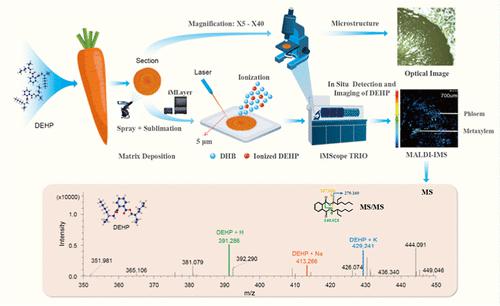当前位置:
X-MOL 学术
›
J. Agric. Food Chem.
›
论文详情
Our official English website, www.x-mol.net, welcomes your
feedback! (Note: you will need to create a separate account there.)
Visualizing the Distribution of Phthalate Esters and Plant Metabolites in Carrot by Matrix-Assisted Laser Desorption/Ionization Imaging Mass Spectrometry
Journal of Agricultural and Food Chemistry ( IF 5.7 ) Pub Date : 2022-11-28 , DOI: 10.1021/acs.jafc.2c06995 Leilei Xiang 1 , Fang Wang 1, 2, 3 , Yongrong Bian 1, 2 , Jean Damascene Harindintwali 1, 2 , Ziquan Wang 1 , Yu Wang 1 , Jing Dong 4 , Hong Chen 1 , Andreas Schaeffer 3 , Xin Jiang 1, 2 , Zongwei Cai 5
Journal of Agricultural and Food Chemistry ( IF 5.7 ) Pub Date : 2022-11-28 , DOI: 10.1021/acs.jafc.2c06995 Leilei Xiang 1 , Fang Wang 1, 2, 3 , Yongrong Bian 1, 2 , Jean Damascene Harindintwali 1, 2 , Ziquan Wang 1 , Yu Wang 1 , Jing Dong 4 , Hong Chen 1 , Andreas Schaeffer 3 , Xin Jiang 1, 2 , Zongwei Cai 5
Affiliation

|
The accumulation of organic pollutants in vegetables is a major global food safety issue. The concentrations of pollutants in vegetables usually differ across different tissues because of different transport and accumulation pathways. However, owing to the limitations of conventional methods, in situ localization of typical organic pollutants such as phthalate esters (PAEs) in plant tissues has not yet been studied. Here, we developed a quick and efficient method for in situ detection and imaging of the spatial distribution of PAEs in a typical root vegetable, carrot, using matrix-assisted laser desorption/ionization imaging mass spectrometry (MALDI-IMS). The use of a 2,5-dihydroxybenzoic acid matrix with a spray–sublimation coating method led to the successful identification of PAEs ion signals. The IMS results showed that a typical PAE–di-(2-ethylhexyl)phthalate (DEHP) was broadly distributed in the cortex, phloem, and metaxylem, but was barely detectable in the cambium and protoxylem. Interestingly, MALDI-IMS data also revealed for the first time the spatial distribution of sugars and β-carotene in carrots. In summary, the developed method offers a new and practical methodology for the in situ analysis of PAEs and plant metabolites in plant tissues. As a result, it could provide a more intuitive understanding of the movement and transformation of organic pollutants in soil–plant systems.
中文翻译:

通过基质辅助激光解吸/电离成像质谱法可视化胡萝卜中邻苯二甲酸酯和植物代谢物的分布
蔬菜中有机污染物的积累是全球主要的食品安全问题。由于不同的运输和积累途径,蔬菜中污染物的浓度通常在不同的组织中不同。然而,由于传统方法的局限性,尚未研究植物组织中典型有机污染物如邻苯二甲酸酯(PAEs)的原位定位。在这里,我们开发了一种快速有效的方法,使用基质辅助激光解吸/电离成像质谱 (MALDI-IMS) 对典型根菜类胡萝卜中 PAE 的空间分布进行原位检测和成像。使用 2,5-二羟基苯甲酸基质和喷雾升华涂层方法成功识别了 PAEs 离子信号。IMS 结果表明,典型的 PAE-二-(2-乙基己基)邻苯二甲酸酯 (DEHP) 广泛分布在皮质、韧皮部和后生木质部中,但在形成层和原木质部中几乎检测不到。有趣的是,MALDI-IMS数据还首次揭示了胡萝卜中糖分和β-胡萝卜素的空间分布。总之,所开发的方法为植物组织中 PAE 和植物代谢物的原位分析提供了一种新的实用方法。因此,它可以更直观地了解有机污染物在土壤-植物系统中的运动和转化。MALDI-IMS数据还首次揭示了胡萝卜中糖分和β-胡萝卜素的空间分布。总之,所开发的方法为植物组织中 PAE 和植物代谢物的原位分析提供了一种新的实用方法。因此,它可以更直观地了解有机污染物在土壤-植物系统中的运动和转化。MALDI-IMS数据还首次揭示了胡萝卜中糖分和β-胡萝卜素的空间分布。总之,所开发的方法为植物组织中 PAE 和植物代谢物的原位分析提供了一种新的实用方法。因此,它可以更直观地了解有机污染物在土壤-植物系统中的运动和转化。
更新日期:2022-11-28
中文翻译:

通过基质辅助激光解吸/电离成像质谱法可视化胡萝卜中邻苯二甲酸酯和植物代谢物的分布
蔬菜中有机污染物的积累是全球主要的食品安全问题。由于不同的运输和积累途径,蔬菜中污染物的浓度通常在不同的组织中不同。然而,由于传统方法的局限性,尚未研究植物组织中典型有机污染物如邻苯二甲酸酯(PAEs)的原位定位。在这里,我们开发了一种快速有效的方法,使用基质辅助激光解吸/电离成像质谱 (MALDI-IMS) 对典型根菜类胡萝卜中 PAE 的空间分布进行原位检测和成像。使用 2,5-二羟基苯甲酸基质和喷雾升华涂层方法成功识别了 PAEs 离子信号。IMS 结果表明,典型的 PAE-二-(2-乙基己基)邻苯二甲酸酯 (DEHP) 广泛分布在皮质、韧皮部和后生木质部中,但在形成层和原木质部中几乎检测不到。有趣的是,MALDI-IMS数据还首次揭示了胡萝卜中糖分和β-胡萝卜素的空间分布。总之,所开发的方法为植物组织中 PAE 和植物代谢物的原位分析提供了一种新的实用方法。因此,它可以更直观地了解有机污染物在土壤-植物系统中的运动和转化。MALDI-IMS数据还首次揭示了胡萝卜中糖分和β-胡萝卜素的空间分布。总之,所开发的方法为植物组织中 PAE 和植物代谢物的原位分析提供了一种新的实用方法。因此,它可以更直观地了解有机污染物在土壤-植物系统中的运动和转化。MALDI-IMS数据还首次揭示了胡萝卜中糖分和β-胡萝卜素的空间分布。总之,所开发的方法为植物组织中 PAE 和植物代谢物的原位分析提供了一种新的实用方法。因此,它可以更直观地了解有机污染物在土壤-植物系统中的运动和转化。










































 京公网安备 11010802027423号
京公网安备 11010802027423号